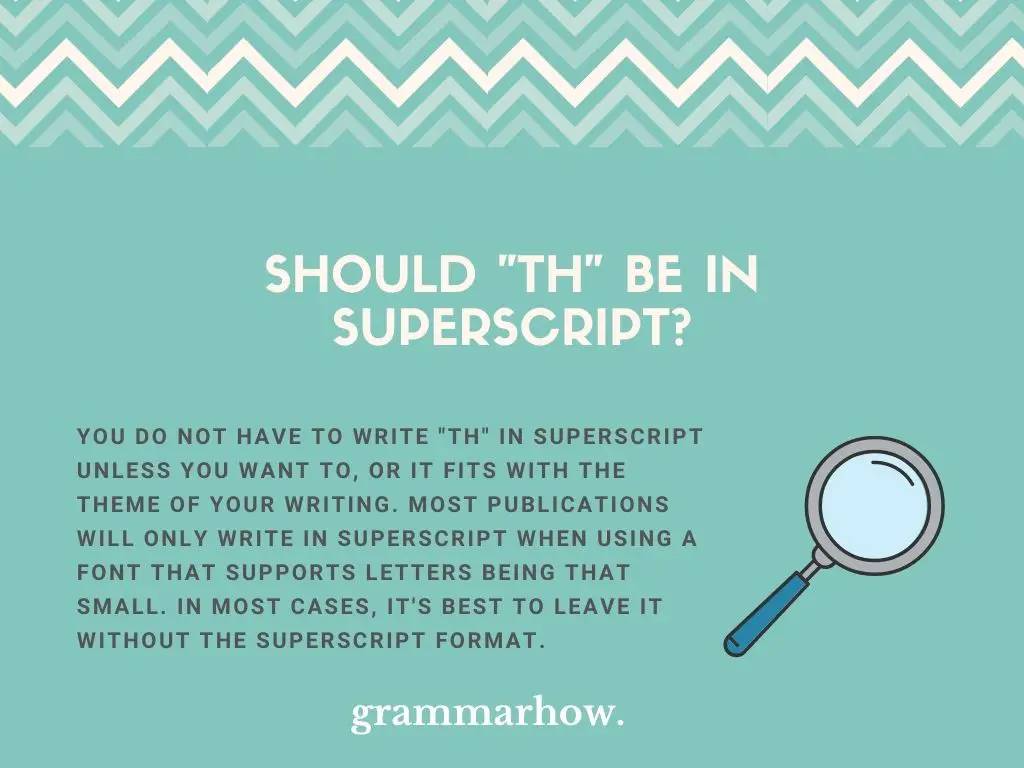When writing about centuries (or using ordinal indicators like 20th in other ways), it would help to know where the “th” goes. There are two options. It can be on the baseline next to the number or just above it in superscript. This article will explain which works best.
Should “th” Be In Superscript?
You do not have to write “th” in superscript unless you want to, or it fits with the theme of your writing. Most publications will only write in superscript when using a font that supports letters being that small. In most cases, it’s best to leave it without the superscript format.

The superscript format has become increasingly less popular in recent years. Some good reasons for this include making it harder to actually create a superscript (by pressing extra buttons) or because some fonts don’t allow for it.
In most cases, if a font doesn’t support smaller letters or numbers being placed above the line of text, it’s not going to look very nice. Most people avoid superscript letters because they don’t work well with their font choice.
When Should I Superscript “th”?
If you are using a suitable font that supports superscript, then you can always use “th” in the superscript format. However, there are no direct rules telling you that this is acceptable or correct over the non-superscript variation.
In formal publications, the superscript format is much more important. You’re more likely to see the following:
- 20th Century
This is because it sticks to the original rules followed by ordinal indicators when they were first introduced with letters to create sequences.
However, even when using a font that supports superscript (the class Arial is a good example), you might not always want to do it. After all, it’s still an extra layer of processing that really doesn’t add much extra to your meaning.
When Should I Not Superscript “th”?
You should not superscript “th” whenever you use a font that doesn’t support the superscript format. It’s also possible to ignore the superscript letters when you don’t think they belong in your writing or think they will take away from the overall point you’re making.
Superscript letters can be distracting. They’re similar to including asterisks or footnote markings, which usually encourage people to refer to another point in your writing (i.e. to establish something in a footnote further down your page).
However, since “20th” isn’t directing anybody to the “th” in the footnote, there isn’t much of a reason to keep it in.
Instead, most people prefer to write the more uniform:
- 20th Century
This is more suitable in most cases because it’s much easier to read. It will fit regardless of the font choice you have as well, which plays in favor of not using superscript.
Let’s imagine that a font is very well-rounded and supports many formats (italics, bold, underlined, etc.) We can use this font to a great degree, and we’re already certain that “20th” works because the individual numbers and letters are recognizable.
However, if we move to superscript in this font and write 20th, we might find that the format breaks down. All of a sudden, the font doesn’t support what we’re trying to say. It’s an extra hurdle that a lot of people don’t like dealing with when “20th” already works just fine!
Is It Correct To Write “th” In Subscript?
Finally, let’s go over when “th” can be in subscript. Again, there are no specific rules to follow here.
Writing “th” in subscript is uncommon. You won’t often see it happen because many people will prefer to write it as “20th.” It’s also much less common than the superscript because ordinal indicators like “th” were originally written in superscript.
However, writing it in subscript is still seen. In fact, you might even recognize a very famous example of it.
20th Century Fox is a great example of “th” being used in subscript. It’s well-known, and everyone recognizes the logo. However, the logo features the “th” in subscript.
Again, this is because of the font choice of Fox Studios. They chose a font that allowed for the “th” to be easily distinguishable when it was on the lower line rather than hanging above the 20.
You may also like: Suffixes “st”, “nd”, “rd”, and “th” – Meaning & Proper Usage
